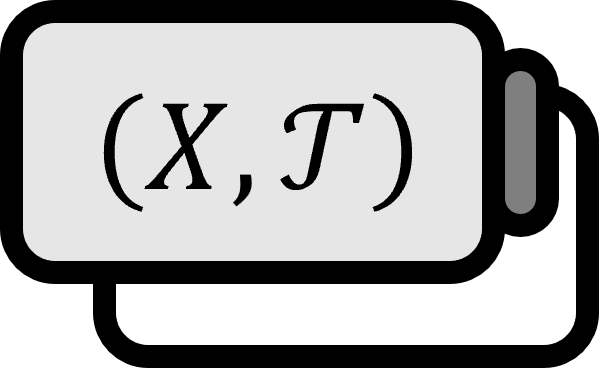Topological Properties
Definition 1
Two spaces $X,Y$ that are homeomorphic share a property $X$. If $Y$ also has this property $P$, then $P$ is known as a Topological Property. Examples of topological properties include:
- [2]: First Countability
- [3]: Second Countability
- [7]: Fixed Point Property
- [9]: Countably Compactness
Explanation
Just as isomorphisms are important in algebra, homeomorphisms are crucial in topology for the same reason. Demonstrating the existence of a homeomorphism allows us to understand that spaces, no matter how different they may appear at first glance, can share various properties. It is also possible to transfer a hard-to-study space to an easier one for analysis.
Proof
Separability
Let’s assume a homeomorphism $f : X \to Y$ exists and $X$ is a separable space. To prove that $Y$ is also separable, we proceed as follows.
Since $X$ is a separable space, there exists a countable subset $A \subset X$ satisfying $\overline{A} = X$. It is evident that $f(A)$ is a countable subset of $Y$, and we need to demonstrate $\overline{f(A)} = Y$.
Since $f$ is surjective, $f(X) = Y$ and being a continuous function implies $f(\overline{A}) \subset \overline{ f(A) }$, thus $$ Y = f(X) = f(\overline{A}) \subset \overline{ f(A) } $$ and summarizing gives $Y \subset \overline{ f(A) }$. Meanwhile, $Y$ is the codomain of $f$, so $\overline{ f(A) } \subset Y$ and thus $\overline{f(A)} = Y$ is proven.
■
First Countability
Assuming a homeomorphism $f : X \to Y$ exists and $X$ is a first-countable space, we aim to show $Y$ is also a first-countable space.
Since $f$ is a continuous function, for every open subset $f(x) \in V$ of $Y$, $x \in f^{-1} (V)$ is an open set in $X$. For all $x \in X$, there exists a local base $\mathscr{B}_{x}$, hence, $$ x \in B \subset f^{-1}(V) $$ there always exists a $B$ satisfying the condition. Therefore, $f(x) \in f(B) \subset V$ and since $f$ is an open function, for all $B \subset \mathscr{B}_{x}$, $f(B)$ is an open set in $Y$. Thus, $$ \mathscr{B}_{f(x)} := \left\{ f(B) \ | \ B \in \mathscr{B}_{x} \right\} $$ is a local base for $f(x) \in Y$, and since $\mathscr{B}_{x}$ is countable, so is $\mathscr{B}_{f(x)}$. As $f$ is a bijection, for every $y = f(x)$, there exists a $\mathscr{B}_{y}$, making $Y$ a first-countable space.
■
Second Countability
Assuming a homeomorphism $f : X \to Y$ exists and $X$ is a second-countable space, our goal is to prove $Y$ is also a second-countable space.
Given that $X$ has a countable base $\mathscr{B} := \left\{ B_{n} \ | \ n \in \mathbb{N} \right\}$,
Since $f$ is a continuous function, for every open set $V \subset y$, $f^{-1}(V)$ is an open set in $X$. Because $\mathscr{B}$ is a base for $X$, $\displaystyle f^{-1}(V) = \bigcup_{i \in I} B_{i}$ and, $$ V = f \left( \bigcup_{i \in I} B_{i} \right) = \bigcup_{i \in I} f( B_{i} ) $$ thus, for every $V$, there exists a countable base $\mathscr{B}’ := \left\{ f(B_{n}) |\ n \in \mathbb{N} \right\}$, making $Y$ a second-countable space.
■
Metrizability
Assuming a homeomorphism $f : X \to Y$ exists and $X$ is a metrizable space, our aim is to show $Y$ is also a metrizable space.
- (i): $d(x,y)=0 \iff x = y$
- (ii): $d(x,y) = d(y,x)$
- (iii): $d(x,y) + d(y,z) \ge d(x,z)$
Given that there exists a distance $d : X \times X \to [ 0 ,\infty )$ transforming $\left( X , d \right)$ into a metric space, let’s define $d’ : Y \times Y \to [ 0 ,\infty )$ as follows: $$ d’(y_{1} , y_{2}) : = d \left( f^{-1} (y_{1}) , f^{-1} (y_{2}) \right) $$ Since $d '$ is defined through the metric $d$, it easily satisfies the conditions to be a metric.
Since $f$ is a continuous function, for every open $ V \subset Y$, $f^{-1} (V)$ is an open set in $X$.
Thus, $$ f^{-1} (V) = \bigcup_{x \in f^{-1}(V)} B_{d} (x, r_{x}) $$ and taking the images yields, $$ \begin{align*} V =& f \left( \bigcup_{x \in f^{-1}(V)} B_{d} (x, r_{x}) \right) \\ =& \bigcup_{x \in f^{-1}(V)} f \left( B_{d} (x, r_{x}) \right) \\ =& \bigcup_{x \in f^{-1}(V)} B_{d’} ( f(x) , r_{x}) \end{align*} $$
- For all $\mathcal{N} ( f(a) )$, $f^{-1} ( \mathcal{N} ( f(a) ) ) = \mathcal{N} (a)$
- [If $f^{-1}$ is continuous, surjective $f : X \to Y$ is an open function.](../435)
Since $f$ is a homeomorphism, $$ B_{d’} ( f(x) , r) = B_{d’} ( y , r) = f \left( B_{d} ( f^{-1} (y) , r) \right) $$ is an open ball in $Y$. Consequently, the set of all open balls $\mathscr{B}’ := \left\{ B_{d’} (y, r) \ | \ y \in Y \land r>0 \right\}$ becomes a base for $Y$, assuring that $Y$ is a metrizable space.
■
Munkres. (2000). Topology(2nd Edition): p105. ↩︎
